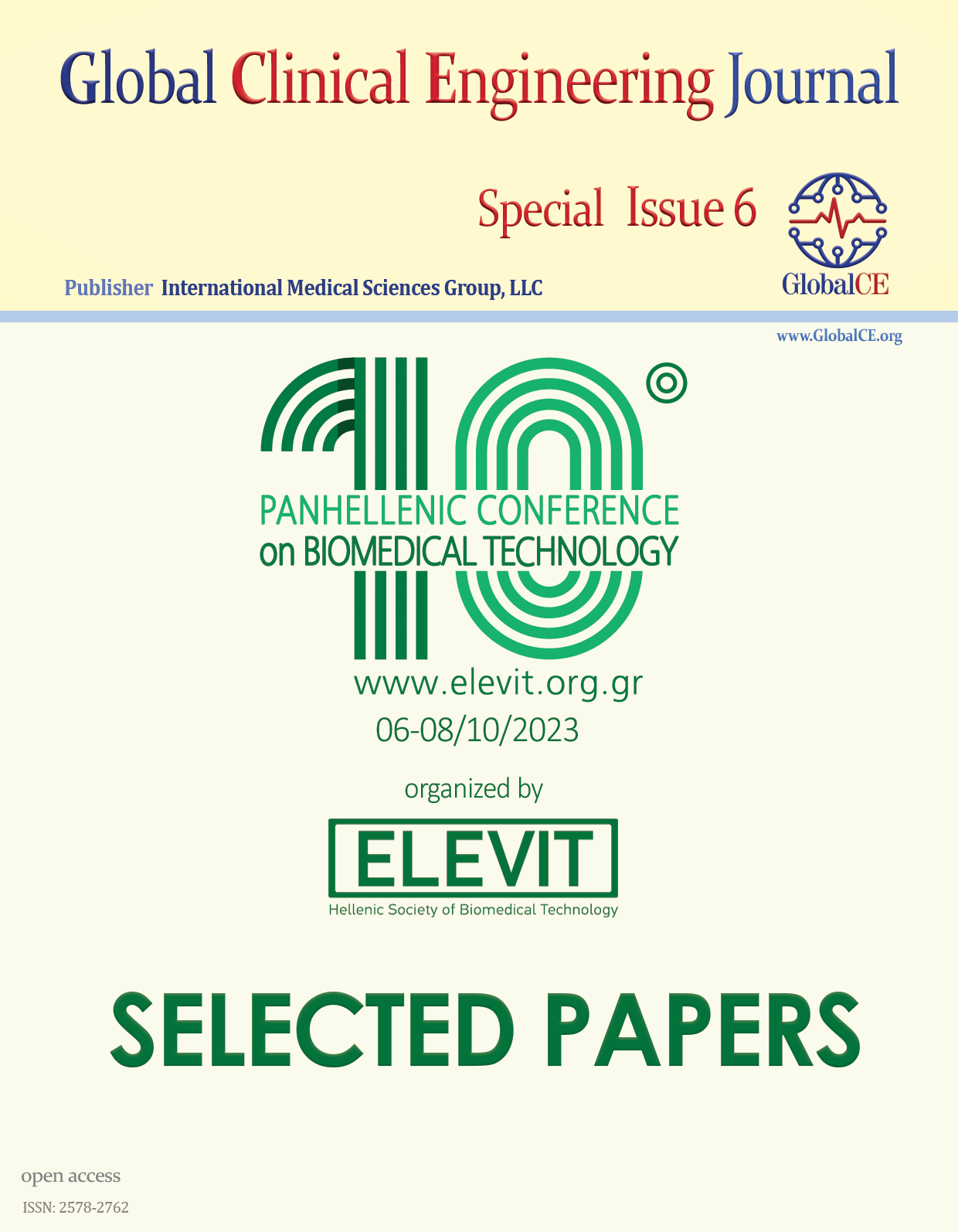Design of a Normative sEMG Database for Biometric Comparison in Rehabilitation Research
Main Article Content
Keywords
Quantitative Electromyography, Rehabilitation, Biomedical Database, NoSQL
Abstract
Electromyography (EMG) is used in a wide range of research fields, such as physiotherapy, ergonomics, and neurorehabilitation. Normative EMG databases play a crucial and significant role in the efficient diagnosis and treatment of neuromuscular disorders. They can rapidly provide information that, although not necessarily diagnostic, can efficiently and effectively guide further diagnostic studies. Quantitative EMG (QEMG) in the upper extremities is an effective diagnostic tool, but there are currently few normative databases available. The absence of fundamental guidelines and established methods for creating normative databases contributes to a significant obstacle in the field of rehabilitation research. This study aims to bridge this gap by designing a dynamic, scalable, consistent, available, and partition-tolerant NoSQL database (DB), in alignment with the Consistency, Availability, and Partition Tolerance (CAP) theorem, to house normative surface EMG (sEMG) values for upper body muscles, primarily for biometric comparison in rehabilitation. The DB encompasses diverse EMG features, both in the time and frequency domains, as well as anthropometric variables, extracted by healthy participants and post-stroke or spinal cord injury patients. The participant selection is based on Greece's average demographic statistics and specific inclusion and exclusion criteria from existing clinical trials. The proposed DB is particularly designed to be continuously updated offering real-time insights, allowing the DB to be an even more valuable resource for researchers and practitioners working in the field.
Downloads
Abstract 503 | PDF Downloads 67
References
10.1016/b978-0-12-374979-6.00011-3.
[2] P. Konrad, ‘The ABC of EMG’, 2006. [Online]. Available: https://www.noraxon.com/wp
content/uploads/2014/12/ABC-EMG-ISBN.pdf
[3] ‘Electromyography: Physiology, Engineering, and Non-Invasive Applications | Wiley’, Wiley.com. Accessed: Jan. 01, 2023. [Online]. Available: https://www.wiley.com/en
us/Electromyography%3A+Physiology%2C+Eng ineering%2C+and+Non+Invasive+Applications+- p-9780471675808
[4] M. C. Pitt and J. Jabre, ‘The problem of lack of normative data in paediatric EMG and possible solutions’, Clin. Neurophysiol., vol. 129, no. 3, pp. 672–675, 2018, doi:
10.1016/j.clinph.2017.11.024.
[5] C. J. De Luca, ‘The Use of Surface
Electromyography in Biomechanics’, J. Appl. Biomech., vol. 13, no. 2, pp. 135–163, 1997, doi: 10.1123/jab.13.2.135.
[6] D. Farina, R. Merletti, and R. M. Enoka, ‘The extraction of neural strategies from the surface EMG’, J. Appl. Physiol., vol. 96, no. 4, pp. 1486– 1495, 2004, doi:
10.1152/japplphysiol.01070.2003.
[7] G. D. Meekins, Y. So, and D. Quan, ‘American Association of Neuromuscular &
Electrodiagnostic Medicine evidenced-based review: Use of surface electromyography in the diagnosis and study of neuromuscular disorders’, Muscle Nerve, vol. 38, no. 4, pp. 1219–1224, 2008, doi: 10.1002/mus.21055.
[8] T. D. Jeppesen, L. Levison, L. Codeluppi, and C. Krarup, ‘Quantitative electromyography:
Normative data in paraspinal muscles’, Muscle Nerve, vol. 62, no. 3, pp. 358–362, 2020, doi: 10.1002/mus.27000.
[9] C. S. Ryan, E. M. Conlee, R. Sharma, E. J. Sorenson, A. J. Boon, and R. S. Laughlin, ‘Nerve conduction normal values for electrodiagnosis in pediatric patients’, Muscle Nerve, vol. 60, no. 2, pp. 155–160, 2019, doi: 10.1002/mus.26499.
[10] E. Brewer, ‘CAP twelve years later: How the “rules” have changed’, Computer, vol. 45, no. 2, pp. 23–29, 2012, doi: 10.1109/mc.2012.37.
[11] A. Davoudian, L. Chen, and M. Liu, ‘A Survey on NoSQL Stores’, ACM Comput. Surv., vol. 51, no. 2, pp. 1–43, 2018, doi: 10.1145/3158661.
[12] A. Athanasiou et al., ‘Neurorehabilitation Through Synergistic Man-Machine Interfaces Promoting Dormant Neuroplasticity in Spinal Cord Injury: Protocol for a Nonrandomized Controlled Trial’, JMIR Res. Protoc., vol. 11, no. 9, p. e41152, 2022, doi: 10.2196/41152.
[13] Konstantinos Mitsopoulos et al., ‘NeuroSuitUp: System Architecture and Validation of a Motor Rehabilitation Wearable Robotics and Serious Game Platform’, Sensors, vol. 23, no. 6, pp. 3281–3281, 2023, doi: 10.3390/s23063281.
[14] S. Rautmare and D. M. Bhalerao, ‘MySQL and NoSQL database comparison for IoT application’, 2016 IEEE Int. Conf. Adv. Comput. Appl. ICACA, 2016, doi: 10.1109/icaca.2016.7887957.
[15] A. Gupta, S. Tyagi, N. Panwar, S. Sachdeva, and U. Saxena, ‘NoSQL databases: Critical analysis and comparison’, IEEE Xplore. Accessed: Jan. 01, 2020. [Online]. Available:
https://ieeexplore.ieee.org/document/8284494
[16] W. L. Schulz, B. G. Nelson, D. K. Felker, T. J. S. Durant, and R. Torres, ‘Evaluation of relational and NoSQL database architectures to manage genomic annotations’, J. Biomed. Inform., vol. 64, pp. 288–295, 2016, doi: 10.1016/j.jbi.2016.10.015.
[17] B. C. Clark, T. M. Manini, D. J. Thé, N. A. Doldo, and L. L. Ploutz-Snyder, ‘Gender
differences in skeletal muscle fatigability are related to contraction type and EMG spectral compression’, J. Appl. Physiol., vol. 94, no. 6, pp. 2263–2272, 2003, doi: 10.1152/japplphysiol.00926.2002.
[18] A. J. Bridges and K. A. Holler, ‘How Many is Enough? Determining Optimal Sample Sizes for Normative Studies in Pediatric Neuropsychology’, Child Neuropsychol., vol. 13, no. 6, pp. 528–538, 2007, doi: 10.1080/09297040701233875.
[19] A. Piovesana and G. Senior, ‘How Small Is Big: Sample Size and Skewness’, Assessment, vol. 25, no. 6, pp. 793–800, 2016, doi: 10.1177/1073191116669784.
[20] Y.-C. Wu and I.-M. Lin, ‘The Resting State of Taiwan EEG Normative Database: Z-Scores of Patients with Major Depressive Disorder as the Cross-Validation’, Brain Sci., vol. 13, no. 2, p. 351, 2023, doi: 10.3390/brainsci13020351.
[21] R. W. Thatcher, R. A. Walker, C. J. Biver, D. N. North, and R. Curtin, ‘Quantitative EEG
Normative Databases: Validation and Clinical Correlation’, J. Neurother., vol. 7, no. 3–4, pp. 87–121, 2003, doi: 10.1300/j184v07n03_05.






